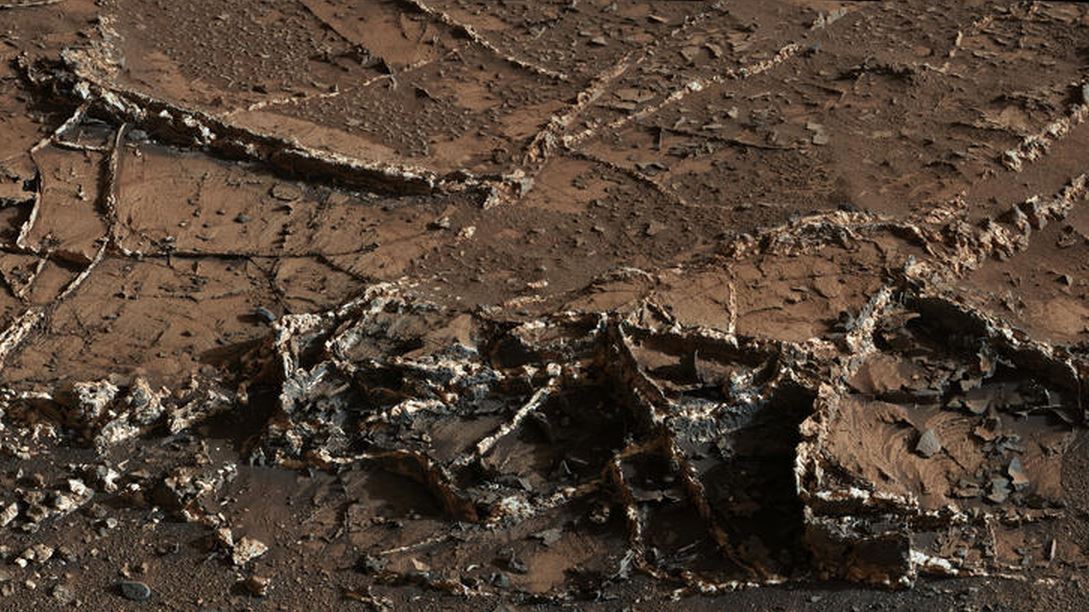NASA’s Curiosity rover has found evidence of liquid movement further up a mountain in Mars, which scientists say suggests the Red Planet had liquid more recently that when a lake existed at the base of the mountain.
Curiosity first found evidence of liquid being present a long time ago from lake-bed deposits at the bottom of a mountain. Further up that mountain, it found evidence pointing to a more recent wet environment on Mars.
In the past seven months Curiosity has analyzed rock samples drilled from three targets lower on the mountain. In each sample it found a different mineral composition, including cristobalite (a silica mineral) in the most recent sample.

These differences, together with prominent veins seen in photographs captured slightly further uphill, illustrate how the layers in the mountain (Mount Sharp) give us a record of different stages in evolution of the area’s ancient environment.
Two-tone veins discovered
The two-tone veins were discovered at the ‘Garden City’ site. They appear as a network of ridges above the eroded bedrock where they were formed. Each ridge ranges up to about 6 centimetres (2.5 inches) high and 3 centimetres (1.25 inches) wide, and they bear both dark and bright material.
Associate Professor Linda Kah, a Curiosity science-team member at the University of Tennessee, Knoxville, said:
“Some of them look like ice-cream sandwiches: dark on both edges and white in the middle. These materials tell us about secondary fluids that were transported through the region after the host rock formed.”
Veins like these are formed after fluids flow through cracked rock and deposit minerals in the cracks, typically affecting the chemistry of the rock around the fractures.
The Curiosity rover has found bright calcium sulfate veins at several previous locations. The dark material preserved in these ridges presents scientists with an opportunity to learn more.
How did later fluids affect the rock?
Prof. Kah said:
“At least two secondary fluids have left evidence here. We want to understand the chemistry of the different fluids that were here and the sequence of events. How have later fluids affected the host rock?”
Some of the sequence is already understood: Mud that formed in lake-bed mudstones must have dried and hardened before the fractures formed, scientists believe after analyzing data gathered from Curiosity near its 2012 landing site and after reaching Mount Sharpe.
Although both flows occurred after the cracks were formed, the dark material that lines the fracture walls points to an earlier episode of fluid than the white calcium-sulfate-rich veins do.
Garden City is about 12 metres (39 feet) higher than the lower edge of the ‘Pahrump Hills’ outcrop of the bedrock forming at the basal layer of Mount Sharp, at the center of the Gale Crater.
Curiosity spent approximately six months analyzing the first 10 metres (33 feet) of elevation at Pahrump Hills, climbing from the bottom edge to higher sections three times to create a vertical profile of the rock structures and chemistry, and to select where best to drill and take samples.
Principal investigator for the CheMin (chemistry and mineralogy) analytical laboratory instrument inside the rover, David Black, who works at NASA’s Ames Research Center, said:
“We investigated Pahrump Hills the way a field geologist would, looking over the whole outcrop first to choose the best samples to collect, and it paid off.”
Three samples are clearly different
Analysis of the three drilled samples taken from Pahrump Hills show they have clear differences in mineral ingredients.
The first – ‘Confidence Hills’ – had the highest concentrations of hematite and clay minerals, both of which typically form under wet conditions.
The second – ‘Mojave’ – had the highest concentration of jarosite, an oxidized mineral containing sulfur and iron that forms in acidic environments.
The third – ‘Telegraph Peak’. Blake said “Telegraph Peak has almost no evidence of clay minerals, the hematite is nearly gone and jarosite abundance is down. The big thing about this sample is the huge amount of cristobalite, at about 10 percent or more of the crystalline material.”
Cristobalite is a high-temperature polymorph of silica, i.e. it has the same chemical formula SiO2, but a distinct crystal structure. The sample also contains traces of quartz, another form of silica.
The researchers suggest that either some process removed other ingredients, leaving behind an enrichment of silica, or that dissolved silica was delivered by fluid transport. It is also possible that the cristobalite was formed somewhere else and was deposited with the original sediment.
Did Mars have microbial life?
NASA’s Mars Science Laboratory Project is using Curiosity to help gather and analyze data from environments that offered favorable conditions for microbial life on ancient Mars, if it ever has hosted microbes, as well as giving insight into the changes from those environments to drier conditions that have prevailed on the Red Planet for over three billion years.
After examining the Telegraph Peak area, the rover research team plans to drive the vehicle through a valley called ‘Artist’s Drive’, to reach more elevated levels.
Engineers are trying to see how Curiosity’s drill can best be used, after a transient short-circuit was detected in March while using the tool’s percussion action to shake rock powder into a sample-processing device. The drill can use both percussion and rotary actions.
Steve Lee of NASA’s Jet Propulsion Laboratory in Pasadena, California, said:
“We expect to use percussion as part of drilling in the future while we monitor whether shorts become more frequent.”
